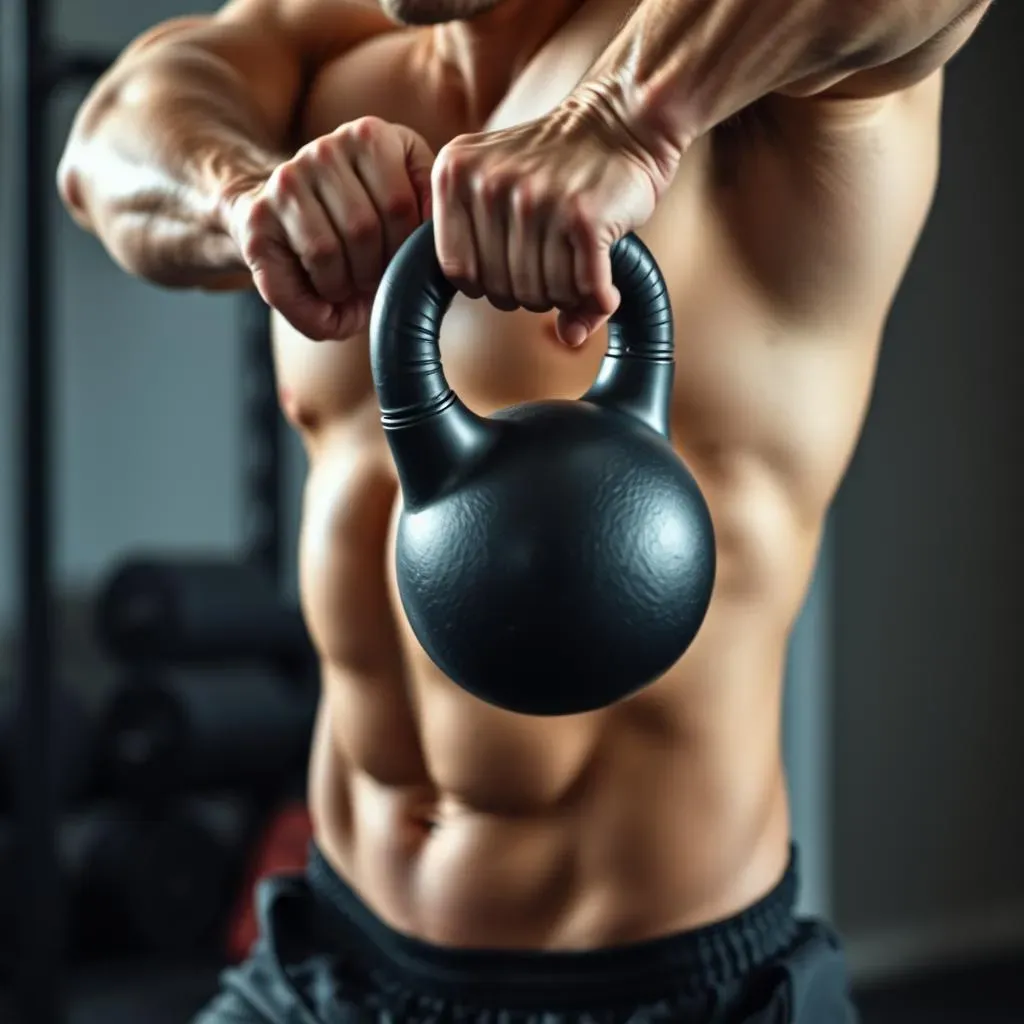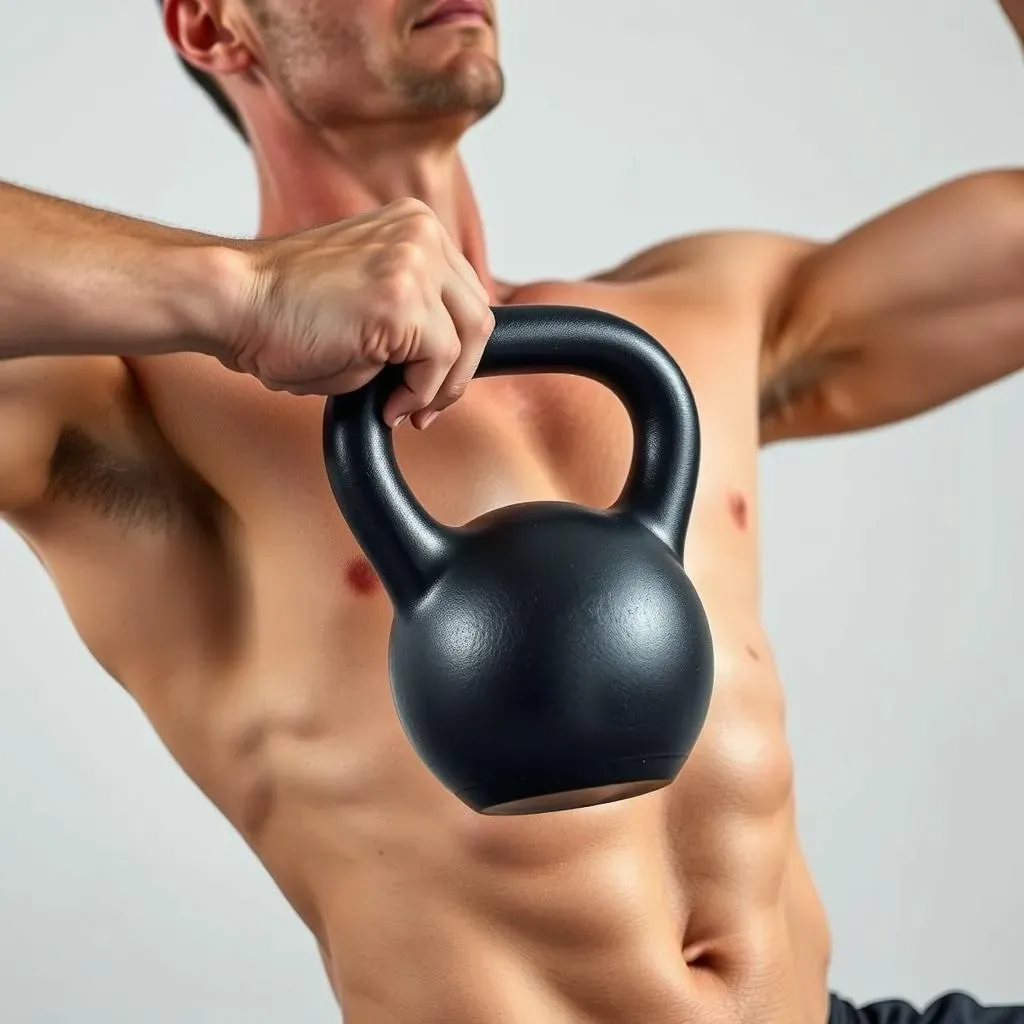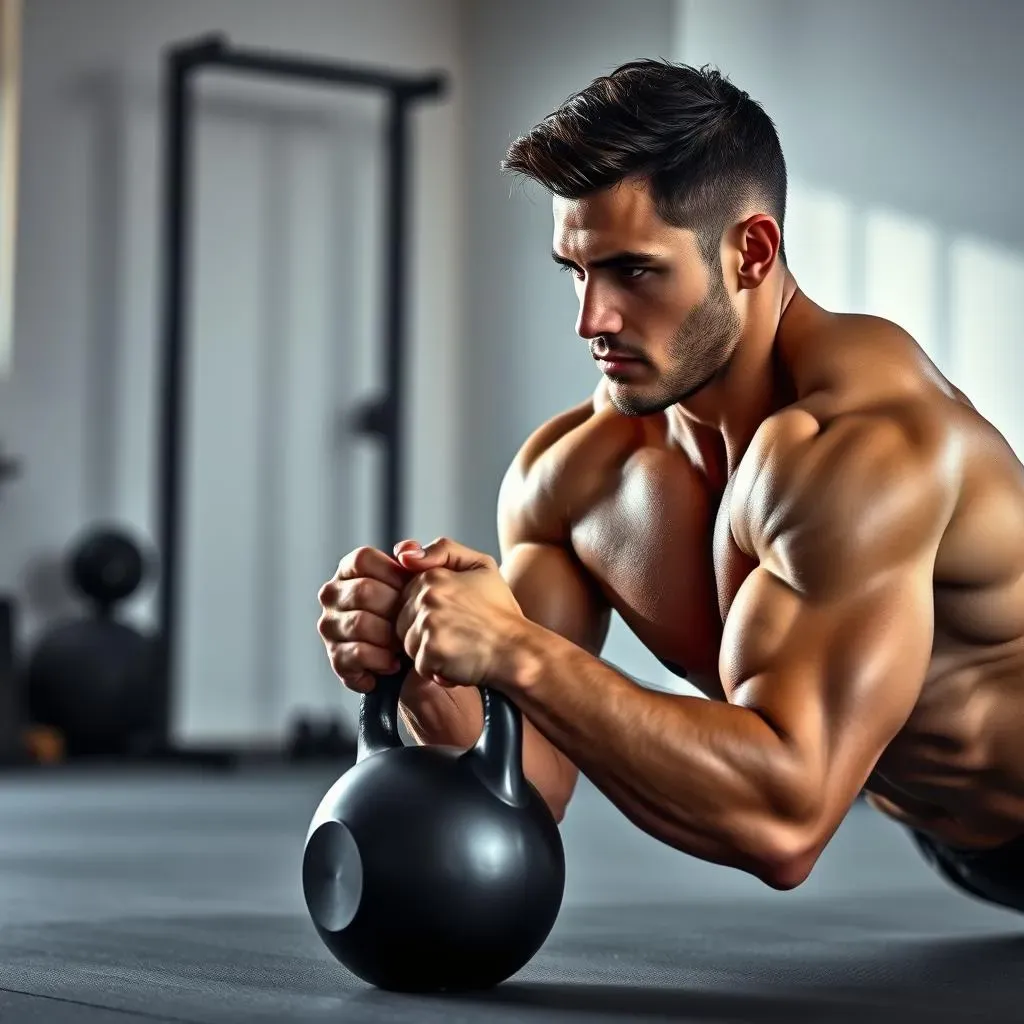Table of Contents
Ready to build a chest that makes people say "wow"? Forget endless push-ups; it’s time to grab a kettlebell. This article isn't about some fancy new fitness fad. It's about using the power of kettlebells to target your pectoral muscles effectively. We're going to explore why these cannonballs with handles are surprisingly awesome for chest workouts. We will look at the top exercises that will challenge your muscles, and give you that chest you've always wanted. We'll also discuss the how-tos, making sure you're not just swinging weight around but actually building strength and size. Think of this as your roadmap to mastering pectoral kettlebell exercises. Whether you're a seasoned lifter or just starting, this guide is packed with tips to help you get the most out of your chest day. We're diving into the nitty-gritty of proper form and how to slide these moves into your existing routine. Get ready, it's time to get your chest in shape.
Why Choose Kettlebell Exercises for Your Chest?

Why Choose Kettlebell Exercises for Your Chest?
More Than Just Swinging Weight
so you might be thinking, "Kettlebells? For chest? Isn't that more of a leg and back thing?" I get it. I used to think the same. But here's the deal: kettlebells aren't just for those explosive swings and squats. They’re actually fantastic for building chest strength and size, in a way that’s different from your usual dumbbells or barbells. It’s not just about lifting heavy; it's about how the weight moves. With a kettlebell, the weight is offset, which means your muscles work harder to stabilize and control the movement. This instability can lead to greater muscle activation, which is exactly what we want when we’re trying to build a strong chest.
Think about it: when you're doing a bench press with a barbell, your hands are fixed and the weight is evenly distributed. With kettlebells, you're dealing with a weight that's constantly trying to pull you in different directions. This forces your chest muscles to engage more throughout the entire exercise. Plus, kettlebells are great for improving your grip strength, which is always a bonus. So, if you’re looking to shake up your chest routine and add a new challenge, kettlebells are your answer. They're not just a trendy piece of equipment; they're a solid tool for serious chest gains.
The Unique Benefits
Let's be real, variety is key when you are working out, and kettlebells bring a unique flavor to chest training. It's not just about adding a new movement; it's about the type of tension and control you get. Unlike dumbbells, where the weight is centered, kettlebells force you to engage your stabilizer muscles more. This means you're not just working your chest; you're also improving your core and shoulder stability, which is crucial for overall strength and injury prevention. It’s like getting a two-for-one deal with every rep.
Another cool thing about kettlebells is that they allow for more natural movement patterns. For example, with a kettlebell floor press, your arm can move more freely, allowing for a deeper stretch in your chest muscles. This isn’t something you’d get with a standard barbell press. And don’t even get me started on the unilateral benefits. Working one side at a time with kettlebells helps to correct muscle imbalances and improve overall coordination. So, if you're looking for a way to build a strong, balanced chest while also improving your overall fitness, kettlebells are definitely worth exploring. They're not just a novelty; they’re a powerhouse for chest development.
Benefit | How it Helps |
|---|---|
Increased Muscle Activation | Offset weight forces more muscle engagement for stabilization. |
Improved Grip Strength | Handling kettlebells builds forearm and grip strength. |
Enhanced Stability | Unstable weight improves core and shoulder strength. |
More Natural Movement | Allows for deeper stretches and better range of motion. |
Unilateral Training | Helps correct muscle imbalances by working one side at a time. |
Top Pectoral Kettlebell Exercises for Strength and Size

Top Pectoral Kettlebell Exercises for Strength and Size
The Kettlebell Floor Press
Alright, let's get into the good stuff: the exercises. First up, we have the kettlebell floor press. It might sound simple, but don't let that fool you. This isn't your average bench press. By doing it on the floor, you're limiting your range of motion, which actually helps to focus more on your chest muscles. It's like giving your pecs a laser-focused workout. Grab a kettlebell, lie on your back, and hold the kettlebell by the handle with your elbow bent. Then, press the kettlebell straight up. You'll feel your chest working hard to push that weight. I like this one because it really lets me feel the contraction in my chest, and it's also a bit easier on the shoulders than a regular bench press.
The key here is control. Don't just heave the weight up; think about squeezing your chest muscles at the top of the movement. And be sure to lower it slowly, feeling that stretch in your chest as you go down. This exercise is great for both building strength and adding muscle mass. It’s a foundational move that should be in every kettlebell enthusiast's chest routine. Plus, it's a good starting point if you're new to using kettlebells for chest work. It's not complicated, but it's effective. So, give it a go and feel the burn.
Incline Kettlebell Press
Next, let's crank up the intensity with the incline kettlebell press. Now, this is where things get interesting. By using an incline, you're shifting the focus to your upper chest, which is often a neglected area for many of us. You can use an adjustable bench, or even a sturdy box or step. The setup is similar to the floor press, but now you're at an angle. This changes the way your chest muscles engage, giving you a more complete chest workout. I personally love the incline press because it really helps to develop that well-rounded look to your chest. It's not just about the size; it's about the shape too.
Now, remember proper form is essential. Keep your core engaged, and your back flat against the incline. As you press the kettlebells up, focus on squeezing your upper chest. Lower the weight slowly, controlling the movement. This exercise is all about slow and deliberate reps. Don't rush it, feel the burn, and you'll see the results. This is a great move to throw into your routine if you're looking to add some serious upper chest development. It's a bit more challenging than the floor press, but definitely worth the effort if you're serious about sculpting a strong chest with kettlebells.
Exercise | Main Muscles Targeted | Why it's Effective |
|---|---|---|
Kettlebell Floor Press | Pectoralis Major | Focuses on chest with limited range of motion, great for beginners. |
Incline Kettlebell Press | Upper Pectorals | Targets the upper chest, creating a well-rounded look. |
How to Properly Perform Pectoral Kettlebell Exercises

How to Properly Perform Pectoral Kettlebell Exercises
Grip It Right
so you've got your kettlebell, and you're ready to go. But hold on a sec; let's talk about your grip. It's not just about grabbing the handle any old way. The way you hold that kettlebell is crucial for both safety and effectiveness. For most chest exercises, you'll want to use a firm, but not death-grip, hold. Imagine you're shaking hands with the kettlebell – firm, but not crushing it. This allows you to maintain control of the weight without over-tensing your forearm. When performing presses, make sure the handle sits comfortably in your palm, not too high or too low. A good grip means better control, and better control means you're targeting your chest muscles more effectively. It's like having a good foundation for a house; if your grip isn't solid, the rest of the exercise will suffer.
And here’s a tip I learned the hard way: don't grip too tightly. A death grip will just tire out your forearms and take the focus away from your chest. You want to be strong, but relaxed. Think of it like holding a bird; you want to hold it securely, but not so tight that you crush it. It takes practice to get it right, but once you do, you'll feel a huge difference in your workouts. Remember, it's not just about lifting the weight; it's about how you lift it. Proper grip is the key to unlocking the full potential of your chest workout.
The Importance of Controlled Movement
Now that you've got your grip down, let's talk about movement. Forget about those jerky, uncontrolled reps you might see in the gym. When it comes to kettlebell chest exercises, slow and controlled is the name of the game. Think of each rep as a mini-performance; you're not just pushing the weight up, you're guiding it, feeling each muscle fiber engage. I know it might be tempting to just throw the kettlebell around, especially when the weight gets heavy, but trust me, you'll get way more out of the exercise if you slow it down. This is where the real muscle building magic happens. It's not about how fast you can finish; it's about how well you can control each movement.
When you lower the weight, resist the pull of gravity. Don't just let the kettlebell drop; feel the stretch in your chest as you control the descent. This is called the eccentric phase of the movement, and it's crucial for muscle growth. And when you push the weight up, focus on squeezing your chest muscles at the top. Think about bringing your elbows together, even though they won't actually move. This helps you to really activate your pecs. So, next time you're working out with kettlebells, remember: slow, controlled, and deliberate. It's not about the number of reps; it's about the quality of each one.
Key Aspect | Description |
|---|---|
Grip | Firm but relaxed, handle comfortably in palm. |
Movement | Slow, controlled, deliberate reps. |
Eccentric Phase | Control the descent, resist gravity. |
Concentric Phase | Squeeze chest muscles at the top. |
Progressive Overload
Alright, you're gripping right, moving slow, and feeling the burn. Now, how do you keep making progress? The answer is progressive overload. This is just a fancy way of saying you need to gradually increase the challenge over time. Your muscles are like stubborn kids; they won't grow unless you give them a reason to. So, if you're doing the same weight for the same number of reps every single workout, your chest muscles are just going to say, "Meh, we're good here." You need to keep pushing them. Start with a weight that's challenging but allows you to maintain good form. Then, as you get stronger, slowly increase the weight, the number of reps, or the number of sets. It's not about trying to go from zero to hero in one workout; it's about making consistent, gradual progress over time.
Maybe one week you add a few extra reps. Maybe the next week you increase the weight by a small amount. The key is to listen to your body and make sure you're not pushing too hard, too fast. It’s like climbing a ladder; you go step by step, not trying to jump to the top. And don’t forget about rest. Your muscles grow when you're resting, not when you're working out. So, be sure to get enough sleep and allow your body to recover between workouts. Progressive overload isn't just a workout principle; it's a lifestyle. It’s about constantly challenging yourself, and always striving to get a little bit better each time you hit the gym. It’s all about the long game, and those slow, consistent gains will add up to some serious chest gains.
Integrating Pectoral Kettlebell Exercises Into Your Workout Routine

Integrating Pectoral Kettlebell Exercises Into Your Workout Routine
Finding the Right Fit
so you're sold on kettlebells for your chest, but how do you actually fit them into your workout routine? It's not about throwing out everything you're doing and starting from scratch. It's about finding the right balance. If you're already doing a solid chest workout with barbells or dumbbells, you can start by swapping out one or two exercises with kettlebell variations. For example, instead of a flat bench press, try the kettlebell floor press. Or, instead of a dumbbell incline press, go for the incline kettlebell press. It's about integrating, not completely overhauling. You might even find that you like the kettlebell variations better. The key is to experiment and see what works best for you. Don't be afraid to mix and match; your workout is your own personal creation.
I've found that the best approach is to start slow and gradually increase the number of kettlebell exercises you're doing. Maybe start with just one kettlebell exercise per chest workout, and then add another one the following week. This allows your body to adapt to the new movements and helps to prevent any injuries. And remember to listen to your body. If something doesn't feel right, don't push it. It's better to take a step back and adjust your plan than to risk an injury that will set you back even further. The goal here is to make kettlebells a sustainable part of your routine, not just a temporary novelty.
Workout Splits and Kettlebells
Now, let's talk workout splits. If you're doing a traditional bodybuilding split, where you focus on one or two muscle groups per workout, then integrating kettlebell chest exercises is pretty straightforward. Just plug them into your chest day. But what if you’re doing a full body workout or an upper/lower split? No problem. Kettlebell chest exercises can fit into any kind of routine. For full body workouts, pick one or two chest exercises and combine them with other total body movements. This is great for building overall strength and fitness. If you're doing an upper/lower split, then your kettlebell chest exercises can be part of your upper body day, alongside exercises for your back, shoulders, and arms. The beauty of kettlebells is their versatility. They're not just for one type of workout. They're a tool that can be used in many different ways, so find what works best for your schedule and your goals.
And here’s a tip: don't forget about your warm-up. Before you start any kettlebell chest exercises, be sure to do some dynamic stretching and light cardio. This will help to prepare your muscles for the workout and reduce the risk of injury. And after your workout, don't forget to stretch. Stretching helps to improve flexibility, reduce muscle soreness, and promote recovery. It’s not just about the lifting; it’s about taking care of your body as a whole. Integrating kettlebells into your routine is more than just adding a new exercise; it’s about creating a well-rounded workout plan that will help you to reach your fitness goals.
Workout Split | Integration Strategy |
|---|---|
Bodybuilding Split | Replace or add kettlebell exercises on chest day. |
Full Body Workout | Include 1-2 kettlebell chest exercises with other total body moves. |
Upper/Lower Split | Incorporate kettlebell chest exercises on upper body days. |
Listen to Your Body
we've talked about the exercises, the form, and how to fit them into your routine, but let’s not forget the most important thing: listening to your body. This isn't a race; it’s a journey. And like any journey, there will be times when you need to slow down or take a detour. If you're feeling sore, tired, or just plain not up to it, don't force yourself to work out. Rest is just as important as the workout. It’s during rest that your muscles recover and grow. So, don’t feel guilty about taking a day off. Your body will thank you for it.
And here's another thing: don't compare yourself to others. Everyone's fitness journey is different. What works for someone else might not work for you. Focus on your own progress and be proud of how far you've come. It's not about being the best; it's about being better than you were yesterday. So, next time you're working out with kettlebells, remember to listen to your body, respect its limits, and celebrate your progress, no matter how small it might seem. It’s all part of the process, and it's the key to achieving your long-term fitness goals.
Wrapping Up Your Pectoral Kettlebell Journey
So, there you have it—a complete guide to using kettlebells for chest development. From understanding why they're effective to mastering specific exercises and integrating them into your routine, you're now armed with the knowledge to sculpt a stronger, more defined chest. Remember, consistency and proper technique are your best friends on this journey. Don't rush the process; focus on mastering the movements, gradually increasing the weight, and always listening to your body. Kettlebells aren't just a tool; they're your partner in achieving your fitness goals. Keep challenging yourself, stay patient, and you'll be amazed at the progress you make. Now go, grab that kettlebell, and make those pecs pop!